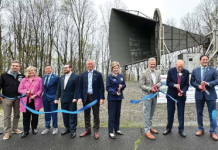By John Burton |
ATLANTIC HIGHLANDS — A resident-drafted plan intended to offer some traffic and parking relief for the borough’s First Avenue doesn’t have county officials’ support.
“I’d say the plan would not gain county approval at this point,” said borough administrator Adam Hubeny.
First Avenue, which is the borough’s main business thoroughfare, is a county roadway and comes under the county purview.
Hubeny, Mayor Rhonda “Randi” Le Grice and Police Chief Jerry Vasto joined county engineers and representatives from the county Public Works Department earlier this month to discuss traffic, pedestrian and vehicular safety issues for the borough, particularly those facing the borough’s commercial district. During conversations with county representatives, the “loop proposal,” as it’s become known locally, came up. However, Le Grice acknowledged, county engineers rejected the proposal because the engineers felt it wasn’t in compliance with the county standards. “And the county found many flaws in the plan,” Hubeny acknowledged.
Borough resident Mark Fisher undertook looking into the issue that has been increasingly of concern to borough officials: namely tackling traffic and insufficient parking along First Avenue.
Fisher drew up a series of plans and accompanying PowerPoint presentations that involved making a portion of First Avenue one way moving east toward the municipal harbor and Seastreak commuter ferry dock. To compensate for that, Fisher’s plan would create a loop, having traffic on a portion of Hennessey Boulevard, a parallel street just north of First Avenue, flow one way in the opposite, westerly direction.
In addition to the new traffic pattern, Fisher’s plan called for angling parking spaces on the one-way portions of First and Hennessey to 60 degrees. That, Fisher had said, would allow for additional spaces in the increasingly busy commercial district.
The problem for county engineers, though, is that to allow angled parking would require a separate back-out lane, according to county guidelines. “And the street is just not wide enough for that,” Hubeny said.
“I just get the feeling there aren’t too many one-way roads that have been approved by them,” Le Grice said, referring to county engineers, who seemed disinclined to allow one-way traffic. When Fisher’s proposal was introduced in May, Le Grice told The Two River Times she was intrigued, especially as it was a relatively easy and inexpensive way to increase parking and address congestion.
“It is a big disappointment,” Fisher acknowledged, noting he had asked but wasn’t allowed to participate in the meeting earlier this month.
Fisher isn’t a traffic engineer but said he had dedicated approximately 200 hours researching and drafting his plan, saying he wanted to offer some, however marginal, remedy. Like many residents, Fisher had become concerned about traffic safety and the parking spill over into residential neighborhoods adjacent to the commercial district, Le Grice explained.
Le Grice said she and others will continue to consider installing angled parking on Hennessey Boulevard, since the borough does “have control over that.”
Borough officials and county representatives discussed other traffic calming initiatives as speed humps, flashing pedestrian crossing lights (such as the one recently installed in the vicinity of Portland Pointe housing complex), additional crosswalks, and signage.
“However,” Le Grice noted, “we have to come up with the money” for those measures.
Monmouth County Engineer Joseph Ettore did not respond to repeated requests for an interview for this story.
Le Grice said traffic enforcement will be ramped up to deal with speeding along the roadway. According to Fisher, when he had conducted a series of public presentations on his plan, questionnaires filled out by residents overwhelmingly said speeding and pedestrian safety were leading issues.
As for parking, some spaces will be added at the eastern end of First Avenue by restriping in the area of the Hesse building, Le Grice said. But with substantial mixed-use residential and commercial developments moving forward in the district, more businesses coming into the community, and the demands for commuter parking for the ferry, Le Grice said parking is something that will have to be handled if progress is to continue.
And that could mean talking about building a garage, the mayor added.
“We got to have that conversation,” she said. “We got to look ahead.”
This article was first published in the Aug. 24-31, 2017 print edition of The Two River Times.














